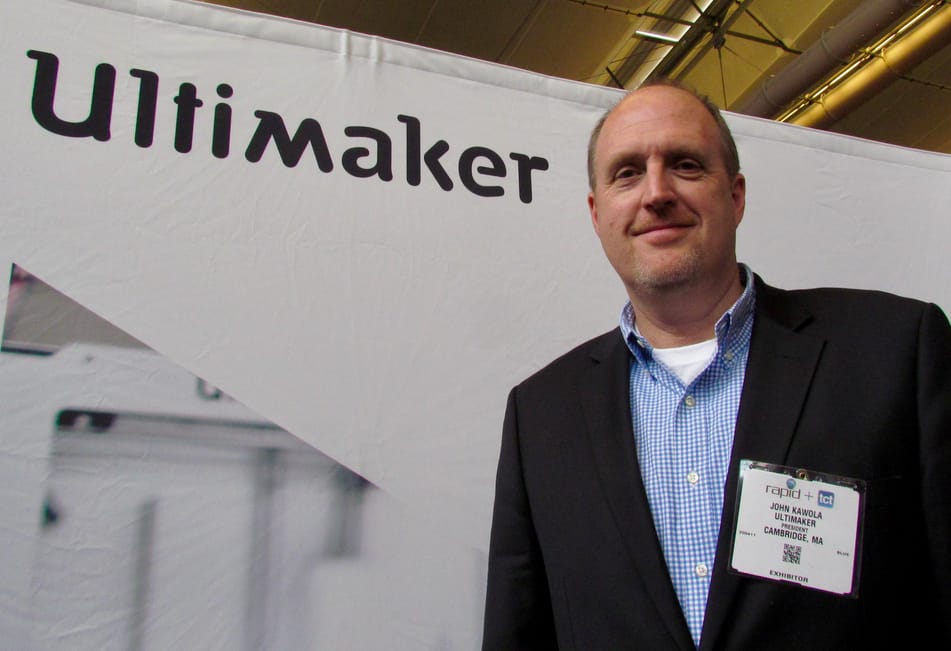
We recently had the opportunity sit down and chat with the new President of Ultimaker North America, John Kawola.
Kawola is very well known in the 3D print world, have spent time with several 3D print-related companies, including Voxel8 and Spaceclaim, but he is most noted for his time at Z Corp, where he was CEO from 2008 to 2012.
At that time ZCorp produced the only full color 3D printer in existence, and in our interview we asked him his opinion of the color 3D print markets.
But since Ultimaker’s announcement of Kawola’s installment as President of their North American operations, we’ll start there.
Fabbaloo: Normally when we speak to Ultimaker we’ve talked with Jos Burger (CEO) or Siert Wijnia (Co-Founder), but now you are running the US operations.
John Kawola: The story is this: Ultimaker is a Dutch company, 200+ people in a town called Geldermalsen which is south of Amsterdam. The company is about five, almost six years old now and the first launched products were in the 2012/2013 time frame.
In some ways they’re very Eurocentric; in some ways like the “European MakerBot”, but the business continued to move along nicely and evolve and change a lot. Not just Ultimaker, but all the desktop 3D printer companies. When they first came out maybe 5 or 6 years ago, they were really only good enough for the maker crowd; that’s hobbyists, the prosumer crowd and schools started to adopt it.
Fabbaloo: But they ran out of customers at that point?
John Kawola: I think what has happened is in that segment of the market maybe there was, and this is my opinion, the people who were true makers, the people who made stuff as a hobby and people who had a lathe in their garage, they were going to buy one and get a lot of use out of it.
The people who actually were not going to do that and were just buying it because “maybe I should buy one”; that’s not a good use of their money. They should have bought another TV instead.
Ultimaker stayed pretty pure to their goal and never really bought into the consumer 3D printer vision. So they sold to the maker crowd, sold to schools. What has evolved now in 2017, what has shifted pretty significantly, is the quality.
It’s not just us, it’s some of our competitors as well. It’s resolution, detail; we can do polycarbonate and ABS and nylon and all these ranges of materials.
The fact that that’s happened in the last two or three years has dragged us into the professional market. We’re now well north of 50% of our business is not to the maker and not to the schools, but to the range of professional users. That range of professional answers could be a two-person architecture firm, or it could be Airbus.
So it’s that whole range that we can break down into two pieces. One is deeper penetration in prototyping. For a lot of these companies, 3D Systems and Stratasys, for example, there was always a level of penetration for prototyping; it’s been around for 20-25 years. It was based on price. $30-40-50,000 is a level of penetration based on ease of use, or “lack of ease of use”, I’ll call it.
Still today, to a certain degree, if you have an Objet machine or Stratasys machine that’s USD$50-100,000, it’s in a room, somebody’s got the key, it’s somewhat centralized. I think what the desktop machines have started to bring is the fact that it truly, as much as people used to say, an engineer has one of these on every desk – that’s starting to become closer to reality.
Fabbaloo: Not for the home resident?
John Kawola: Not for the home resident, it’s for the professional user. It’s starting to become more real.
Fabbaloo: Is that literally true? One per desk? Or is it more like, say, one per department?
John Kawola: If the ratio used to be one to 50, now the ratio is maybe one to 10 or even one to 5, and shrinking. It’s because of the price point and because it’s simpler to use.
That’s a big part of our business: getting deeper penetration and prototyping than was ever was there before, and the second part of it is us getting dragged into jigs, fixtures and tools and maybe even short run production.
Everybody in this building is talking about, whether you are a million dollar sintering machine or Ultimaker, we are all talking about it. As much as maybe we didn’t have the foresight to think about it in the last 18 months or two years, our customers started just buying machines and doing it.
They come back to us saying they’re “making jigs, fixtures and tools” and it was almost in reverse. We’re like “Really?”
So there are some forward-looking customers in big companies. There’s a case study from Volkswagen; they’re as sophisticated as anybody and they’re using Ultimakers. Because of the price! We’ve got racks of Ultimakers all over the world. They’re not quite as automated as Stratasys’ new demonstrator, but we have 10 machines or 12 machines on a rack.
Just this past weekend we did a big education conference at Duke University. Duke has 50 of them servicing all the students. And down the road at Chapel Hill, North Carolina they’ve got 25. All on a rack. The benefit of “many small” versus “one large machine” is throughput, for one.
Then it’s redundancy and flexibility. I can be printing this one in this color, and this one in that color and getting different things. If one of them doesn’t work, which will happen, the other eight do work.
This is part 1 of a 2 part interview. See part 2 here.
Via Ultimaker

